by Bill Murray
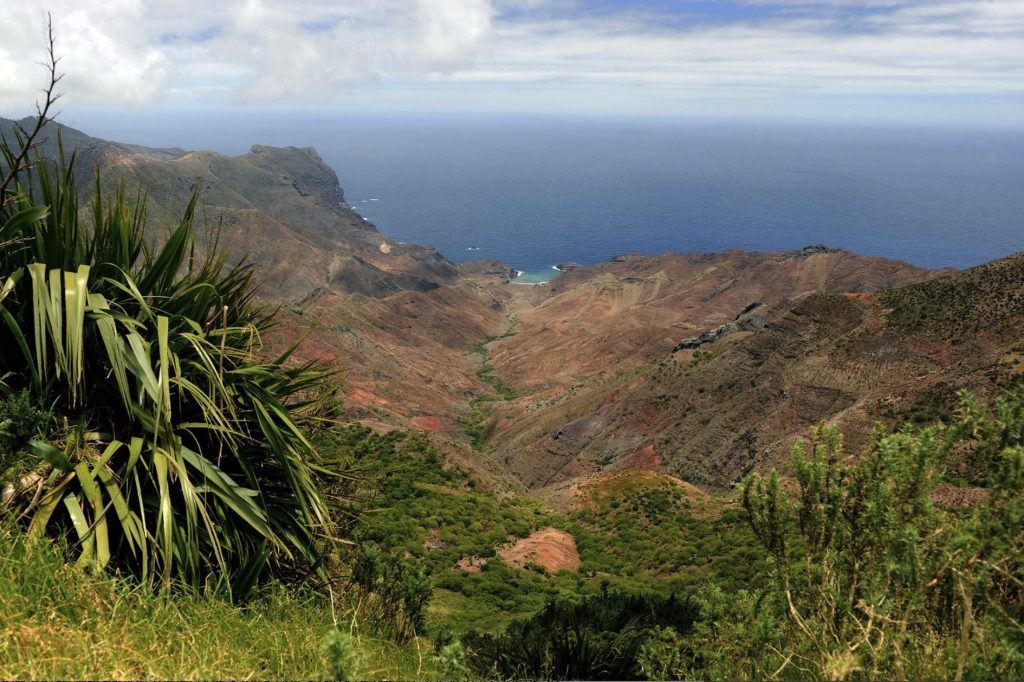
Once we thought we’d look into a cruise. As skeptics in principle, we agreed we’d have to choose carefully. We wouldn’t join an enforced entertainment experience with a thousand shipmates enduring professional smiles.
We wouldn’t just pocket a few easy off-the-beaten-track conquests (although these look promising). The fun of those is getting there on your own. This ruled out a queasy crossing of the Drake Passage with newly retired strangers. Fine.
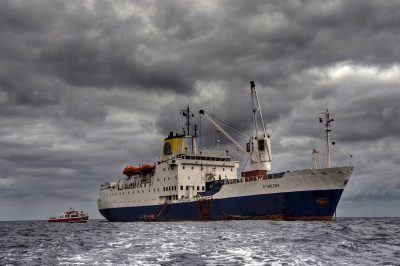
We wouldn’t sail anyplace that made our fellow cruisers too keyed up to have fun. This ruled out anything billed as a “trip of a lifetime.” Them’s marketing words. Finally, we hadn’t the free time for tramping aboard a cargo ship, although Gregory Jaynes’s Come Hell on High Water makes a strong case. One of these days.
We settled on sailing from Walvis Bay, Namibia on the world’s last royal mail ship, the RMS St. Helena, a stubby little bulldog bound for St. Helena and Ascension Islands, some 1800 miles east of Brazil and 1200 miles west of Angola, in the middle of the South Atlantic Ocean, among the more remote places on earth.
•••••
You know those waist-high metal poles they pull straps between, for you to queue in airports and theaters? Staff rolled those poles around the floor, dancing them into an obstacle course before they looked up at any of us ticket holders. The airport’s early shift, bleary-eyed, just getting to work, their days destined to be different from our own.
We held those limp, slick, mimeo-style hand-written air tickets (the way they used to do it) from O. R. Tambo airport in Johannesburg to Walvis Bay. Alas, possession of tickets was 9/10 of nothing. Apparently, few cared to visit the Namibian coast that day, so they summarily cancelled the flight, sending us scurrying back to the airport hotel.
Here was a bit of a dilemma. There was no flight to Walvis Bay before the RMS St. Helena sailed, and no other flight to Namibia at all except to the capital, Windhoek, on the day of the sailing. Windhoek looked like about a four hour drive from the coast if you knew where you were going. In theory, and with no other choice, we thought we might just make it.

A harried car rental; a heavy foot on the floor. A mad barreling across the B1 and B2 highways; nobody out there. West with the sand-flies, blowing through map points called Wilhelmstal (a farm), Karibib (a quarry town grown from a Herero waterhole) and Arandis, serving a uranium mine. Spat blind at last out of the desert into the main town out that way, Swakopmund. The coast.
Twenty miles to go. Our imploring, bulging eyes alarmed each group of helpful folk we asked for directions. And then we’d make it worse, spinning away in sand clouds. We’d never raced across an African desert before.
High strung, faking it, we barreled into the port and blundered about the dockyard until we found people, at the sailor’s bar. We handed over the car keys blind to a kind lady at the Walvis Bay Mission to Seafarers. She must have returned it to Hertz for us, for we heard nothing further. We are grateful.
I fancy a memory of tires squealing up to the gangway dusting the epaulets of an RMS attendant with Namib Desert sand, time clock running out, cinematic score rising to crescendo as we attained our small tourist glory. It was nothing like that. No crescendo, no epaulets, no triumph. Maybe a raised eyebrow.

Dock workers tossed the lines, the tender Flamingo turned the ship around and on leaving the harbor the St. Helena fired up her engines, set a course, and then never wavered for three and a half days, steady chugging northwest, constant speed, never changing heading, moving farther and farther from land. Now we had no choice but to relax.
They would thumb tack statistics like these each morning:
Day One:
– Distance traveled, 255 Nautical Miles
– Average speed, 15.4 knots
– Distance remaining, 976 Nautical Miles
– Nearest land: 135 Nautical Miles east in Angola
Day Two:
– Distance traveled the last 24 hours, 375 Nautical Miles
– Average speed, 14.6 knots
– Distance remaining 611 Nautical Miles
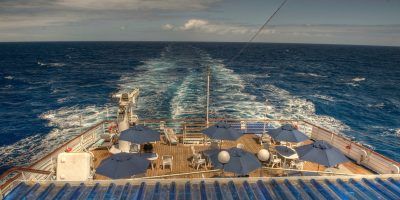
Imagine: as recently as ten years ago this Mail Ship really did deliver the mail. There was no airport and no other ships called. And sure enough, the RMS St. Helena was unadorned with water slides, circus acts or mini golf. No underwater bars, bumper cars, and not a single rock climbing wall. The most rambunctious activity we all got up to was a quoits contest on the aft deck after dinner. Hoo boy.
Mid-journey, Second Mate Maya (a Saint, as they call St. Helena natives) conducted a tour of the bridge. For three days we explored the ship’s nooks and crannies, finding (then neglecting) the fitness room and the little shop.

Welcome to St. Helena (“Saint He LEE na”) Island, South Atlantic Ocean, as remote a spot as anyone without family there is likely to go. The ship cannot dock. We climb on motorboats and the Saints come down and haul everybody ashore by hand, one by one.
You get off by yourself for a long time, you get quirky. Everybody does. I can’t speak for now, but ten years ago St. Helena, with pointedly few places to drive, was an island with a parking problem. More cars than people. Quirky, but unthreatening, a graceful interior, high panoramas of a rocky coastline surrounded by endless sea. Benign, unlike the wild tropical mainland. No dinner plate-sized baboon spiders.
Also no cell phone service ten years ago. That came in 2015. Home phone numbers were four digits.
We hired an engaging guide named Hensel Peters, who drove us all over.
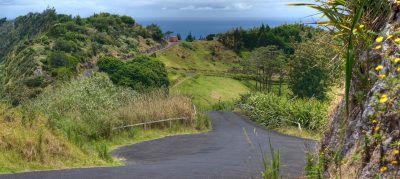 This is a tiny road way out toward Diana’s Peak, at the back of the island on a high ridge over the Atlantic Ocean. Look how the prevailing winds have shaped some of the trees.
This is a tiny road way out toward Diana’s Peak, at the back of the island on a high ridge over the Atlantic Ocean. Look how the prevailing winds have shaped some of the trees.
•••••
The Brits sailed Napoleon into exile here. There is no chance that you will come all this way and not go and see Longwood House, where he lived.

Gracious and comfy, sturdy and low-key, its modesty calls to mind FDR’s Little White House, and Höfði House on the edge of Reykjavik, the site of Reagan and Gorbachev’s summit. None in real life match the mythic expectations of leaders’ circumstances (Potsdam’s Cecilienhof Palace, that one does, maybe.
They brought the Sicilian all the way out to St. Helena then sequestered him well across the island from the main settlement, called Jamestown, a living museum, the world’s most remote theme park, at the mouth of a bare, rocky, inhospitable wedge that affords the only place to come ashore, albeit without a proper dock. Most Saints live in Jamestown, a Georgian era museum piece.
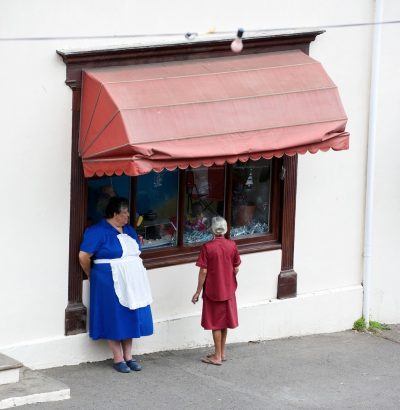
The Saints’ lethargic decorum comes naturally. On the benches along Market Street you’d be hard-pressed to find a Saint rising in opposition to much of anything, really, or even rising to her feet in a hurry.
•••••
Life is not like that where scolding Guardian columnists vie for their salaries, back in London. Simon Jenkins called the Falkland Islands “Britain’s expensive nuisance,” and truth be told, St. Helena deserves a place on that nuisance list.
Ten years ago the U.K. entirely supported its 4255 people (2008 census), solely via the RMS St. Helena. (Last month I wrote about another backwater British colony, Anguilla, which the Brits actively tried to give back. I expect that if they had their way, they’d give St. Helena back, too.)
While Britain’s second oldest remaining colony (1659) was born with real strategic value as a way station for ships en route around to South Africa and Asia, forty-two hundred people is an awkward size. Too few for factories, even were there a good way to get exports off the island. It’s not even big enough for a supermarket, really. Business would struggle with scale, were entrepreneurial spirit evident in the first place. There aren’t enough jobs, and all the young folks flirt with leaving. Saints make up a substantial part of the work force on nearby (a relative term) Ascension Island.
•••••
World tourism in 2020 is in full hand-wringing lament. It may be consolation (if not comfort) to recall that not everything in this word went famously in the pre-pandemic good old days either. Two cases in point:
– St. Helena’s airport, inaugurated in 2015, was snakebit from before the beginning. They built an entire airstrip and terminal, then final pre-opening testing revealed an unplanned-for propensity for wind shear. Best I can tell, South Africa’s Airlink airline now runs weekly flights with smaller Embraer E190 aircraft to lessen wind shear concerns, dashing long-held hopes for planeloads of tourists.
– Our visit came just before the South African World Cup (Remember the vuvuzela? There’s one thing that would be even less welcome in a crowd in Covid Time than it was then.) The World Cup, 2300 miles away, caused a near extinction event at St. Helena’s grand old hotel.
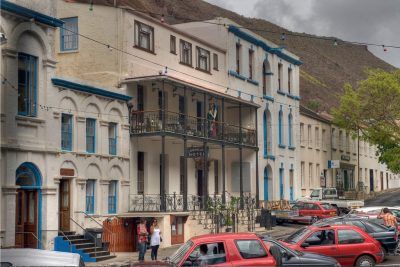
The Consulate Hotel’s promotional literature was frank: “Access to the island is limited to the number of calls made by the RMS St. Helena. As a result the hotel and guest related services on its own are not sustainable, and the hotel relies on the public bar for its survival.
“Unfortunately, this public service can at times be a bit uncomfortable for residents in terms of activity and result in noise, especially when the ship is in port and on the weekends. We sincerely apologize for this….”
The Consulate’s proprietress, a diminutive woman named Hazel, stood in the corridor of her hotel, bouncing a tiny girl in nappies. About 50, with close-cropped sandy-to-gray hair, she gave me the unvarnished lowdown. The power bill was £11000 a quarter and insurance added two and a half, three to that, so right there, before salaries, she was in for £14000.
In a perfect world the guest rooms would pay that and she could start from there, paying salaries with proceeds from the bar and snack bar and restaurant. As usual, this was not a perfect world.
She would have to close the hotel for six months, she said, maybe April until October. There were no bookings then. This meant she would terminate 16 of 20 staff, retaining only her four senior managers, fearing if she let them go they would never return. Some of the sixteen would voluntarily go on a month leave and that would help. She would bleed the remaining four salaries personally, as straight up, vivid, from her pocket losses.
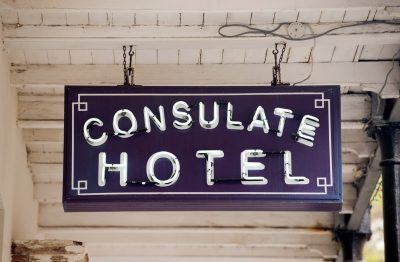 The reason for no bookings was the World Cup. There were no hotel rooms in Cape Town and the European airlines, she said, had raised airfares unconscionably to make hay with international football fans, so would-be visitors to St. Helena couldn’t afford to transit the only country from which a ship sailed to St. Helena.
The reason for no bookings was the World Cup. There were no hotel rooms in Cape Town and the European airlines, she said, had raised airfares unconscionably to make hay with international football fans, so would-be visitors to St. Helena couldn’t afford to transit the only country from which a ship sailed to St. Helena.
(The RMS St. Helena was to cease operations from Walvis Bay about two weeks from our departure, citing low passenger demand. Walvis Bay was the only other port supplying tourists to St. Helena.)
Plus, and Hazel stamped her foot, with reduced demand for passenger bookings that summer, the RMS had applied to be a floating hotel off Cape Town for the games. If they didn’t sail to St. Helena for a month or more, she hadn’t even a shot at housing tourists.
Sometimes God puts obstacles in your way only to open doors later on, she said. If she could see her way through this, I thought, she would surely make it from there. She hoped so too.
The RMS crew responded that they never meant to be a floating hotel during the games, except for two nights prior to a scheduled sailing, accommodating passengers who otherwise wouldn’t have a place to stay. And Chief Officer Peter Milton told us they always only meant to call at Walvis Bay as an experiment, to see if it attracted cargo or new passengers. They’d shown the flag for five years, it didn’t, so they would pull the plug.
They did. And with the coming of the airport the RMS St. Helena was retired entirely in 2018. Today, Hazel Wilmot still runs the Consulate Hotel, and Airlink advertises flights to St. Helena once a week, via Johannesburg, on Saturdays.
•••••
Next time we’ll continue aboard the mighty RMS St. Helena 600 miles north to explore Ascension Island.
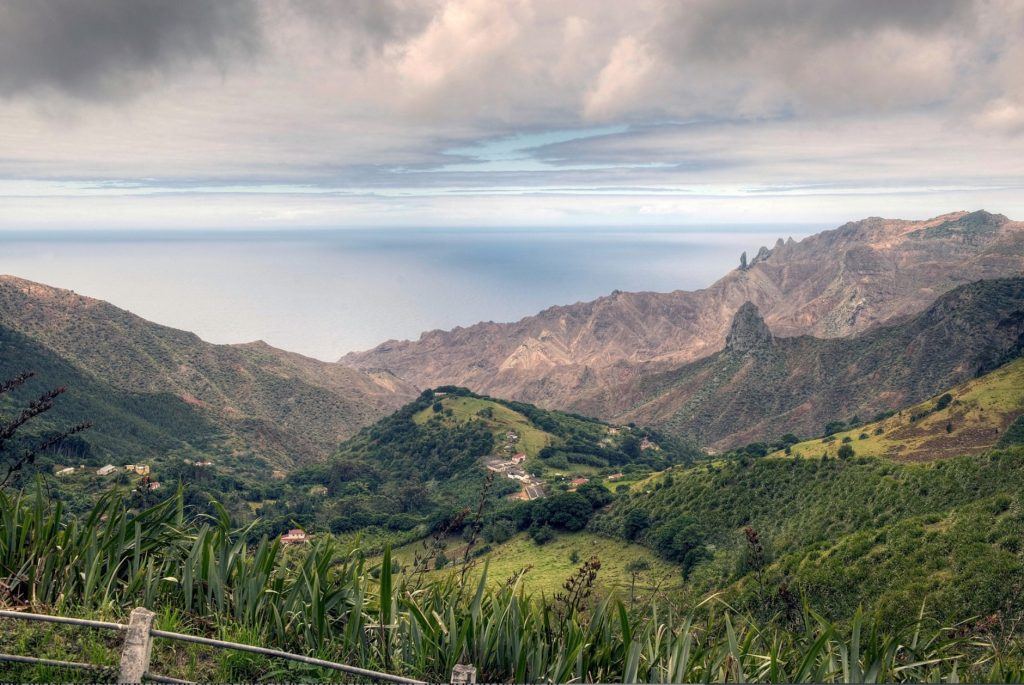
Here are more photos from quirky little St. Helena Island.
